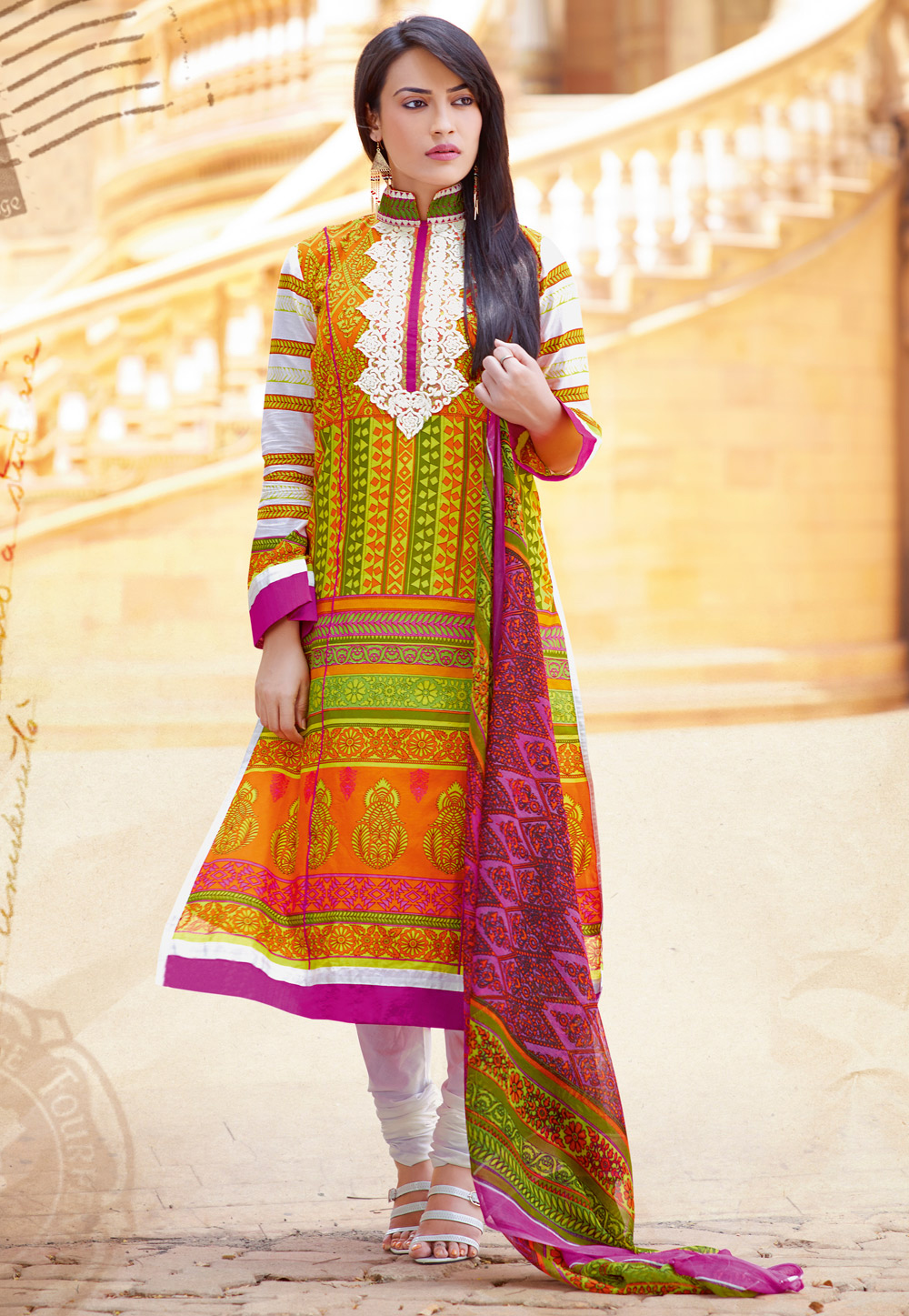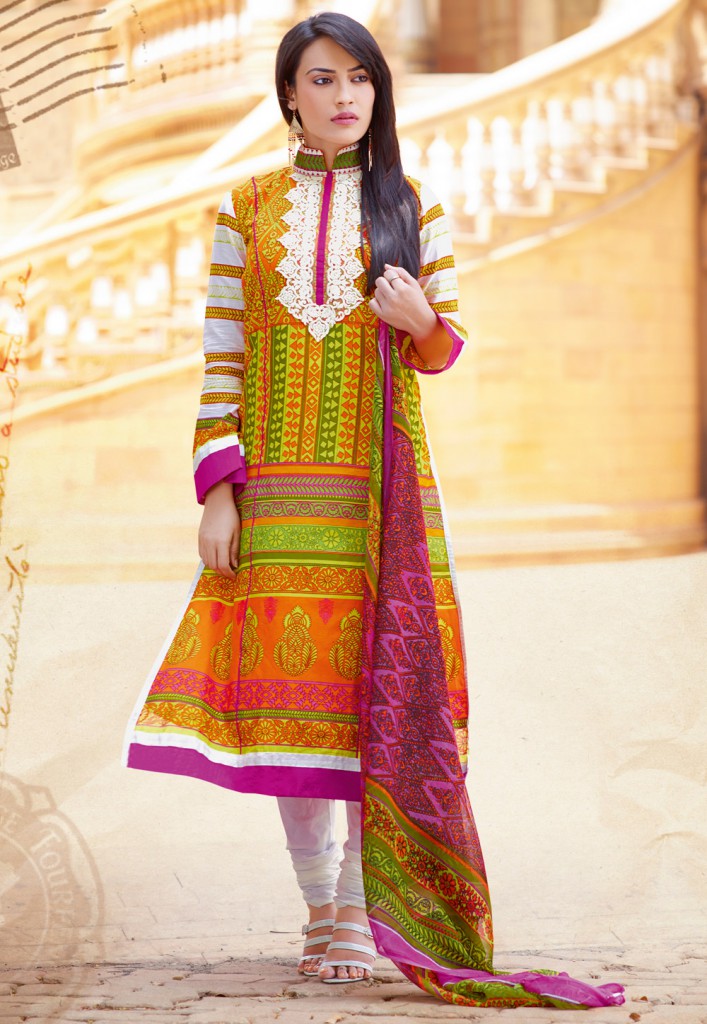
Lawn Suits
Lawn suits are traditional salwar kameez made in a fabric known as ‘lawn’. Originally made from linen, Lawn is now made from cotton and is one of the lightest fabrics that are part of an Indian design house’s collection of textiles. Ideal for warm weather, Lawn suits are all about flaunting prints, designs, colors and everything else that is vibrant on a bright summer day. Usually, lawn suits are worn for informal and/or semi-formal occasions and have become a big deal as part of Indian ethnic spring collections in the last few years.
History & Background
Lawn, the fabric, was initially produced in Laon, France using linen yarns. Lawn from France was imported to India initially till the time India took over the production process and used cotton yarns to create salwar-kameez and churidar-kameez in the fabric. This, however, took place in British occupied India and at the time of the partition of India, the producing lawn and lawn suits were contained majorly in Pakistan.
Textile giants and fashion designers agree that the status of lawn in Pakistan is equivalent to the status of silk in India. Lawn suits were brought into the mainstream ethnic Indian fashion market only in the mid-2000s. Since then its popularity has been increasing steadily as the ideal summer fabric for an Indian spring / summer ensemble.
Sources of Inspiration
Lawn suits in India have been inspired by the extensive collections of Lawn suits that are part of Pakistan’s culture and heritage. Although the inspiration for the use of the fabric has been taken from the neighbors, the motifs, patterns and designs are more contemporary and focused on digital printing and not embroidery.
The Making
The important thing to know about the making of lawn suits is the way in which the fabric is created, as that is the specialty of lawn suits. There are no characteristic designs or motifs that go into the creation of lawn suits or a definitive silhouette that is peculiar to them; making the fabric the highlight of the outfit.
Lawn is made of very fine threads and the fabric itself has a very high thread count. Only even yarns are used to prepare the fabric in an even weave. The completed fabric is smooth and lacks any definitive texture in the form of lumps or knots. A crisp finish is then applied to the fabric.
This fabric is then used to create suits in a variety of color combination and silhouettes and is often embellished with digital printing in modern motifs such as splashes of color, geometric prints, swirls and the like.
Style and Variety
The variety in lawn suits is so vast that it is not really possible to capture all the definitive details. However, since lawn is a fabric that always comes back in fashion during spring and summer the styles it occurs in are in keeping with the trends of that particular season. For instance, lawn suits with laced necklines and edges were all the rage in the 2014 spring-summer collection. Another trend spotted in 2014 was the use of neon colors either exclusively on the suit or in combination with warm or cool colors, neon green with red, yellow and black.
Here are some popular features of the 2014 lawn suits’ collection
- Length of the kurta: Long kurtas that extended up to the calves came back in fashion with lawn suits.
- Sleeves: Although there are many lawn kurtas that are sleeveless or have short sleeves, the most popular kind were full-sleeves kurtas. Since the fabric is so light it is very comfortable to carry and gives the opportunity to flaunt some really beautiful prints on the sleeve as well.
- Necklines: The neckline of lawn suits is often embellished differently than the rest of the kurta (although it is possible to have a plain neck lawn kurta). The Chinese collar was also brought back in vogue with lawn suits although other cuts are just as easily available.
- Bottom wear: Though salwars or patialas are an option offered along with many lawn kurtas, what did make news were the cotton lawn cigarette pants with lace embellishments on the cuff. Besides cigarette pants, churidars and leggings are also a popular choice in lawn suits.
- The suits come with a dupatta in similar colors that also feature similar patterns and prints. However, the extent of the print depends on the dupatta depends on the amount of embellishment on the kurta. If the kurta is heavily printed, the dupatta is kept simple and minimal and vice versa.
As is the case with suit tailoring in India, lawn suit pieces can also be purchased and then specifically tailored.
Present Day Scenario and Global Influence
Lawn suits have been an integral part of designer collections and have been featured in a big way on international runways over the last few years. Inspired by the trending silhouettes and prints, fashion houses have produced and sold many lawn suits in India especially the urban centers. Lawn suits have still not permeated into the urban-rural areas of India, essentially because the target market of lawn suit producers are young, working women in big metros such as Delhi, Mumbai and Bangalore.
Wearing the Attire
Lawn suits can be paired with dangling earrings that set off the beauty of the overall print on the fabric. Also, it is a better option to wear stilettos or platform heels with them as they enhance the posture of the wearer and go with the overarching theme of elegance and grace.
Maintenance
Lawn as a fabric can be easily maintained by washing in the machine on a regular setting. However, they should not be dried directly in the sun as the colors on them may fade. Besides this, they do not need any form of special care such as dry cleaning. Normal ironing of the suit is sufficient.
Facts and Trivia
- Currently, lawn suits are known for having the busiest prints in Indian ethnic wear.
- Heavy embroidery such as stonework or zari work is not meant for lawn suits. Digital printing and lace embellishments are preferred to such extravagant work.
- Anarkali cuts in lawn suits are one of the latest styles in this genre.
- Lawn suits are a combined play on color and prints in order to make the ensemble appealing, bold yet elegant.
Categories: Attires, Clothing Styles & Drapes

